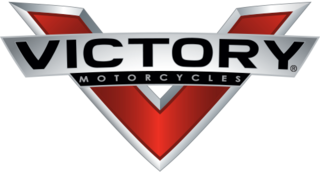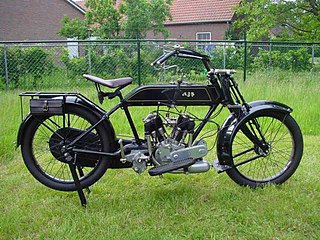
The Birmingham Small Arms Company Limited (BSA) was a major British industrial combine, a group of businesses manufacturing military and sporting firearms; bicycles; motorcycles; cars; buses and bodies; steel; iron castings; hand, power, and machine tools; coal cleaning and handling plants; sintered metals; and hard chrome process.

Motorenwerke Zschopau GmbH is a German motorcycle manufacturer located in Zschopau, Saxony. The acronym MZ since 1956 stands for Motorenwerke Zschopau GmbH. From 1992 to 1999 the company was called MuZ, an acronym for Motorrad und Zweiradwerk.

Velocette is a line of motorcycles made by Veloce Ltd, in Hall Green, Birmingham, England. One of several motorcycle manufacturers in Birmingham, Velocette was a small, family-owned firm, selling almost as many hand-built motorcycles during its lifetime, as the mass-produced machines of the giant BSA and Norton concerns. Renowned for the quality of its products, the company was "always in the picture" in international motorcycle racing, from the mid-1920s through the 1950s, culminating in two World Championship titles and its legendary and still-unbeaten 24 hours at over 100 mph (161 km/h) record. Veloce, while small, was a great technical innovator and many of its patented designs are commonplace on motorcycles today, including the positive-stop foot shift and swinging arm rear suspension with hydraulic dampers. The business suffered a gradual commercial decline during the late 1960s, eventually closing in February 1971.

Adler was a German automobile and motorcycle manufacturer from 1900 until 1957. Adler is German for eagle.

A U engine is a piston engine made up of two separate straight engines placed side-by-side and coupled to a shared output shaft. When viewed from the front, the engine block resembles the letter "U".

Brough Superior motorcycles, sidecars, and motor cars were made by George Brough in his Brough Superior works on Haydn Road in Nottingham, England, from 1919 to 1940. The motorcycles were dubbed the "Rolls-Royce of Motorcycles" by H. D. Teague of The Motor Cycle newspaper. Approximately 3048 motorcycles were made in the 21 years of production; around a third of that production still exists. T. E. Lawrence owned eight of these motorcycles and died from injuries sustained when he crashed number seven; the eighth was on order. Moving forward to 2008, vintage motorcycle enthusiast Mark Upham acquired the rights to the Brough Superior name. In 2013 he met motorcycle designer Thierry Henriette and asked him to design a new Brough Superior motorcycle. Three months later a prototype of a new SS100 was shown in Milan.
The Scott Motorcycle Company was owned by Scott Motors (Saltaire) Limited, Shipley, West Yorkshire, England and was a well-known producer of motorcycles and light engines for industry. Founded by Alfred Angas Scott in 1908 as the Scott Engineering Company in Bradford, Yorkshire, Scott motorcycles were produced until 1978.

Victory Motorcycles was an American motorcycle manufacturer with its final assembly facility in Spirit Lake, Dickinson County, northwestern Iowa, United States. It began production of its vehicles in 1998, and began winding down operations in January 2017.
Phelon & Moore manufactured motorcycles in Cleckheaton, Yorkshire, England from 1904 to 1967 particularly those under the Panther marque. They became identified with one particular design of motorcycle which had a large sloping 40-degree single-cylinder engine as a stressed member of the frame. This design spanned the entire history of the company, starting with a 500 cc model and ending with a 645 cc model.

Matchless is one of the oldest marques of British motorcycles, manufactured in Plumstead, London, between 1899 and 1966. A wide range of models was produced under the Matchless name, ranging from small two-strokes to 750 cc four-stroke twins. Matchless had a long history of racing success; a Matchless ridden by Charlie Collier won the first single-cylinder race in the first Isle of Man TT in 1907.
Lloyd Cars Ltd was a British motor manufacturer, founded by Roland Lloyd (1904–65), son of a garage owner, and based in Patrick Street, Grimsby, Lincolnshire, England between 1936 and 1951. Two models were made, separated by World War II; the company was unusual for a small manufacturer in making nearly all components in-house. After car production ceased the company continued in general engineering until 1983. During World War II the company made components for Rolls-Royce Merlin aircraft engines.
Henderson was a manufacturer of 4-cylinder motorcycles from 1912 until 1931. They were the largest and fastest motorcycles of their time, and appealed to both sport riders and police departments. Police favored them for traffic patrol because they were faster than anything else on the roads. The company began during the golden age of motorcycling, and ended during the Great Depression.
The Yezdi Roadking was a motorcycle produced in India by Ideal Jawa Ltd, Mysore from 1978 to 1996. It was based on the CZ 250 motocross ridden by Jaroslav Falta to the runner-up spot in the 1974 motocross world championship. It was sold under the brand name Yezdi. The bike won several Indian rallies and road races. The bike had a 250 cc engine with dual exhausts and a semi-automatic clutch and Jawa/CZ's trademark integrated gear shifter/kick-starter.

The Royal Enfield Bullet was originally an overhead valve single cylinder four-stroke motorcycle made by Royal Enfield in Redditch, Worcestershire, now produced by Royal Enfield (India) at Chennai, Tamil Nadu, a company originally founded by Madras Motors to build Royal Enfield motorcycles under licence in India. The Royal Enfield Bullet has the longest unchanged production run of any motorcycle having remained continuously in production since 1948. The Bullet marque is even older, and has passed 75 years of continuous production. The Royal Enfield and Bullet names derive from the British company having been a subcontractor to Royal Small Arms Factory in Enfield, London.

In internal combustion engines, a split-single design is a type of two-stroke where two cylinders share a single combustion chamber.

The CS1 was a Norton motorcycle between 1927 and 1939. Originally built as a TT racer, and Norton's first design of an overhead cam engine, it proved successful as a TT Replica road bike.

The BSA M20 was a British motorcycle made by Birmingham Small Arms Company (BSA) at their factory in Small Heath, Birmingham. Although initially viewed as a near failure by the War Office in 1936, the M20 evolved into one of the longest serving motorcycles in the history of British military motorcycling, as well as becoming the most numerous type produced for World War II with 126,000 in active service. Many are still in use around the world today.

The Rudge Ulster was a British motorcycle manufactured by Rudge-Whitworth from 1929 until the outbreak of World War II.

The AJS Model D is a British motorcycle made by A. J. Stevens & Co. Ltd in Wolverhampton between 1912 and 1925. With production halted by the First World War AJS managed to develop the Model D into a popular sidecar machine and it was eventually replaced by the larger capacity AJS Model E.

The BSA Model E was a British V-twin motorcycle manufactured by Birmingham Small Arms Company (BSA) at their factory in Armoury Road, Small Heath, Birmingham from 1919. It was often used with the matching BSA sidecar.















